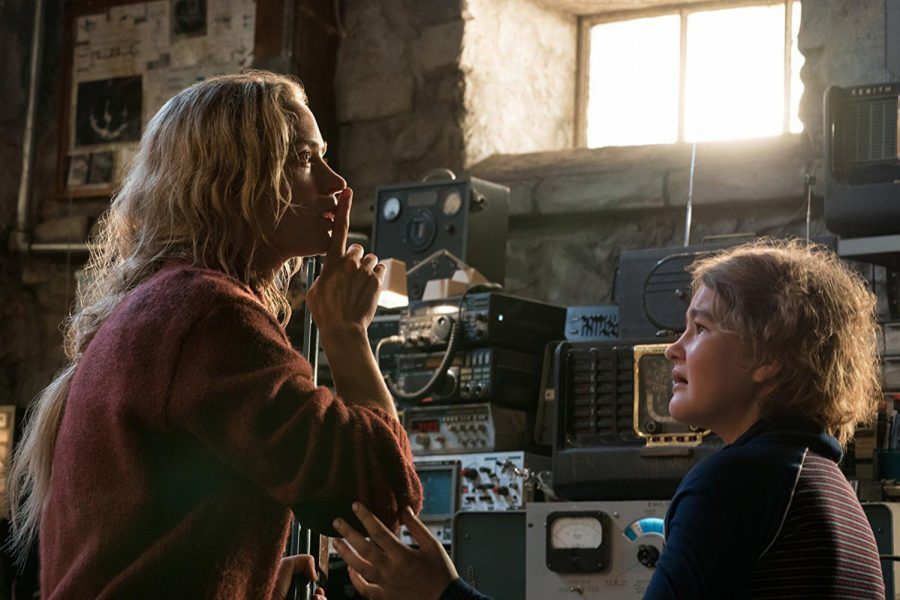It wasn’t until I sat down in a crowded theater to watch John Krasinski’s “A Quiet Place” that I truly understood the power of a silent audience. Through the film’s tension-filled narrative, the screen became the puppet master, with everyone in the theater under its noiseless control. There was no crackling of popcorn — no one even dared clear their throat — and unlike pretty much every other film I’ve ever watched in a Cinemark theater, the “silence your cellphone” PSA was taken with the utmost respect. However, this use of silence, while entertaining in the large setting of a theater, quickly becomes an overused gimmick in “A Quiet Place,” and the result feels forced, synthetically structured and entirely too serious for its voiceless world to be as terrifying as it is silly.
“A Quiet Place” is centered around a simple and captivating idea: What would it be like to live in a world where silence was the only way to stay alive? To explore this unique concept, we follow a family of four as they live out their everyday lives in complete and utter silence, with Krasinski (who many will remember as Jim Halpert from NBC’s “The Office”) and his real-life wife, Emily Blunt, playing the nameless parents of a young boy (Noah Jupe) and girl (Millicent Simmonds). Any sound can and will attract the attention of blind, lethal beasts that have invaded Earth, and this reality creates an unprecedented amount of tension.
To give credit where credit is due, “A Quiet Place” has a particularly intricate amount of detail, which makes the world feel developed and carefully constructed. Every mindless task and chore that we undertake in our everyday lives, like doing the laundry or even eating, instantly becomes a million times more difficult because of the prohibition of sound. Cooking is done underneath the floorboards, plates are replaced with large pieces of lettuce to reduce the risk of breaking and speaking can only be done through sign language and the use of a complex lighting system. Trying to live peacefully has never been more stressful, and “A Quiet Place” basks in this horror from start to finish.
Even with these everyday challenges, the family attempts to hold onto any ounce of normality and optimism that remains in this dreary dystopia. Krasinski and Blunt’s parental roles keep us engaged by way of their emotional and heartfelt performances, which give the film a very thought-provoking message on the sacrifices parents must endure to keep their children safe. In such a quiet reality, the entire cast is still able to emit incredible emotion, similar to Sally Hawkins’ performance in “The Shape of Water,” and it absolutely blew me away. Simmonds, who is deaf in real life, is especially commanding of the screen and will win you over effortlessly.
These moments of true actor responsibility are when “A Quiet Place” really shines, as it forgoes its jump-scare structure to make room for characterization. It’s clear that Krasinski cares deeply for the people he’s conjured up, and I found myself really connecting with this family because of this, even though I didn’t know a single one of their names or backstories. Yet, while his admiration over his created family is refreshing, he takes advantage of their charm to force innovation, and it’s brutally frustrating.
Despite the film’s concept and cast being fantastic, its hook of an idea winds itself so tightly around the narrative that, at times, nothing else can squeeze through. Silence becomes the only concern amongst the characters, and while this creates some truly memorable tension and terror, it becomes a crutch that drags the narrative through the mud. This creates pacing issues and predictability, which ultimately take away from the scares and character building that start out so strong.
Following this, the film takes inspiration from a slice of Swiss cheese as it features numerous plot holes that cloud the believability of the fictional world. Vague answers about what type of world exists beyond the family’s farmhouse make it difficult to ground your feet in the setting; and when this is added to the forced story elements that are clearly just made to cause tension rather than harness organic fear, the result is less innovative as it is tangled and self-infatuated.
The biggest attribute that causes this problem is that the film is obsessed with itself. It wants so badly to be innovative and distinguished that nothing feels natural — it’s all just part of the staging. With this comes a loss of narrative trust which the audience took note of, no longer fearing sound and beginning to giggle at certain character choices and actions. Together, these issues mesh into a giant pile of jumbled ideas and missed opportunities, unable to overcome the hurdles of cinematic silence, ultimately making “A Quiet Place” a gimmicky experience worthy of a frustrated scream.
Charlie Turner can be reached at [email protected] and read at CharliesCut.com.



















